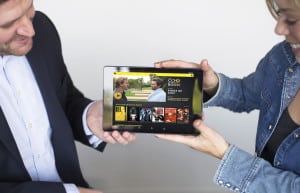OTT Players Debate What it Takes to be Successful

Seth Laderman, EVP and GM of Comic-Con HQ, left and IBM Project Manager Terri Dillon view the new Comic-Con HQ subscription video on-demand platform. Photo: Mike Palma/IBM
[Via Satellite 04-21-2016] Leaders in the Over-the-Top (OTT) video market agreed at the NAB Show in Las Vegas, Nev., that though nonlinear media has exploded in popularity, making a profitable business model is still a hefty challenge. Speaking at the conference’s “To Stream or Not Stream: What Content Owners Should Consider When Going OTT” on April 18, representatives from AOL, Roku, IBM and Ellation debated what it takes to make a new OTT service successful.
Internet-enabled distribution methods have opened the doors for content providers to reach audiences without necessitating the use of satellite or cable, effectively lowering this barrier to entry. The introduction and success of OTT platforms like Netflix, Hulu, Amazon, YouTube and an ever-growing number of others, has spurred on even greater interest in new business models. Panelists cautioned, however, that getting into the OTT business requires careful planning.
“We see a lot of services, at least at this moment, that are launching and then are ‘floating out in the ocean,’ and don’t know what they need to do to acquire, engage and retain customers,” said Arlen Marmel, VP of marketing and distribution at Ellation. I think it is really an end-to-end experience. If you look at the traditional value chain, you need all the capabilities of product, technology, marketing, distribution and of course content programming. I think there are a lot of key pieces that go into it.”
Ellation counts AT&T and the Chernin Group as investors, and owns the popular Anime streaming service Crunchyroll. Marmel listed having the right technology, means of discovery, personalization and recommendation engines as some of the top requisites for having a successful OTT service today.
“What we’re seeing is the need to have a strong platform that is as competitive as you can be with Netflix, which is very hard to do if you are building things in house,” added Braxton Jarratt, general manager of IBM’s Cloud Video Services Unit and CEO of Clearleap. IBM is supporting customers such as HBO, Lionsgate and Comic-Con on video streaming services. Jarratt said consumers expect to access OTT content everywhere, including newer devices such as Sony’s PS4 and Microsoft’s Xbox One, and that they expect to access it anywhere geographically.
“You might be able to get content rights just in North America, but the world is global, Netflix is global, the audiences are moving around the world all the time … it’s not just reaching somebody in those markets or sending a stream to another market, it’s actually doing business in those markets all around the world,” he cautioned.
Andrew Ferrone, VP of pay-TV at Roku, said his company often spends the bulk of their time with content owners on promotion. Roku has invested in tools that engage users who are not streaming as much to prevent waning interest. The company has risen to become one of the top players in the OTT space, with 5.5 billion hours of online video streamed last year, up from 3 billion the year prior, according to Ferrone.
“Today we’ve got over 500 apps, that are signed onto Roku, so you can sign up with one click on the platform. It really helps streamline customer acquisition,” he said.
Panelists were circumspect of whether or not established broadcasters could make the jump to OTT.
“I think for big media companies it is going to be really hard to take your core asset that you are getting billions of dollars from cable, satellite and telco, and putting it out there. The brands are doing that. HBO is doing it and several others are. If you have enough strength as a brand and enough negotiating power then I think you’ll do that, but what we’ll see more of is big brands that think about the different kinds of assets they have that are non-traditional … and using those,” said Jarratt.
That does not mean, however, that new content owners are not looking to satellite and cable as effective means of distribution. Marmel said content owners are pursuing alls kinds of ways to monetize valuable assets, including diverse means of sending content.
“They are licensing content to third party aggregators outside of certain windows and geographies, then they are having their own direct-to-consumer service, and then they are still oftentimes licensing to traditional cable-satellite telcos where that is still frankly where the biggest bang for your buck is essentially,” he said.
Perhaps unexpectedly, the explosion in OTT popularity has not correlated directly to a decline in viewers watching content on televisions as opposed to other devices. Ferrone cited a Hulu study that found PC viewers are shifting over to using televisions for streaming, making TV-connected streaming devices more popular.
“Roku is really focused on the TV platform. We obviously have watched and seen phenomenal growth in mobile video really since the introduction of the smartphone, but the reality is, for TV and movies and the kind of content you want to just veg out to, people prefer their TVs,” he said.
As media companies determine if and how to go OTT, David Simon, VP of inventory acquisition at AOL, encouraged them to experiment and trial new methods aggressively. He said AOL has done this by pushing out original content with third party OTT services, trying new concepts with mobile content and bringing in licensed content from other companies. The goal, he said, is to understand why failures happen and to learn from them very quickly.